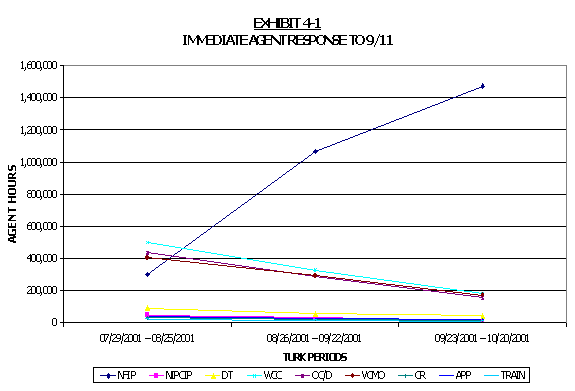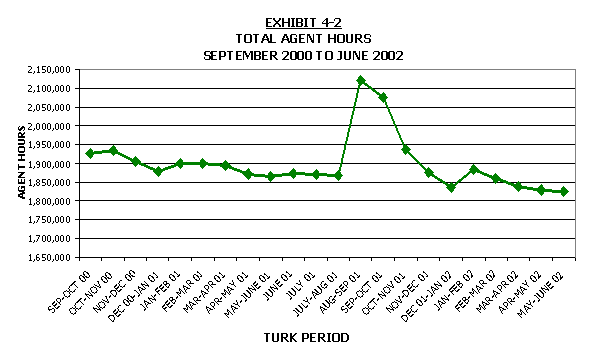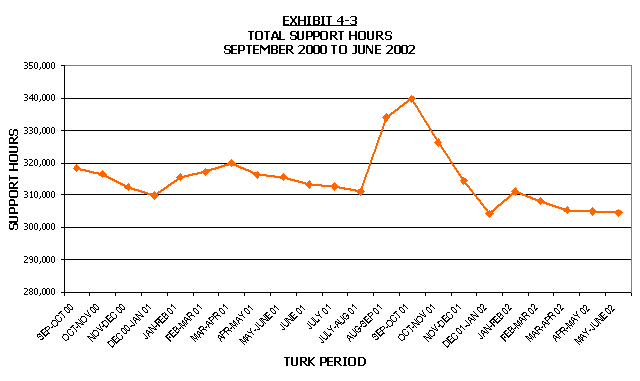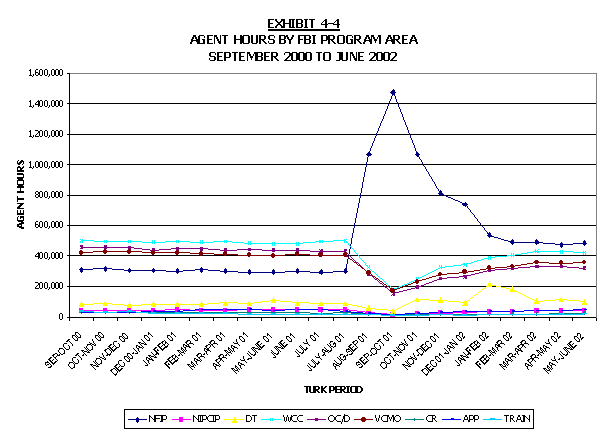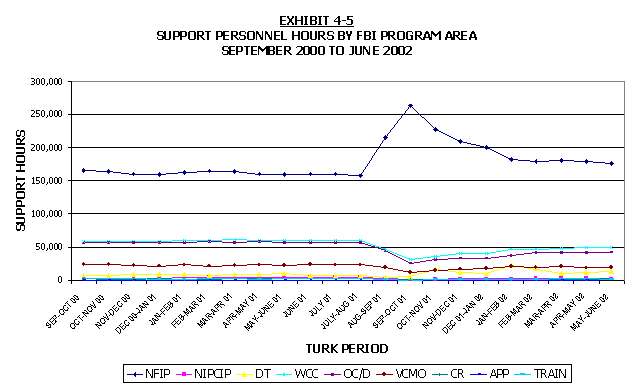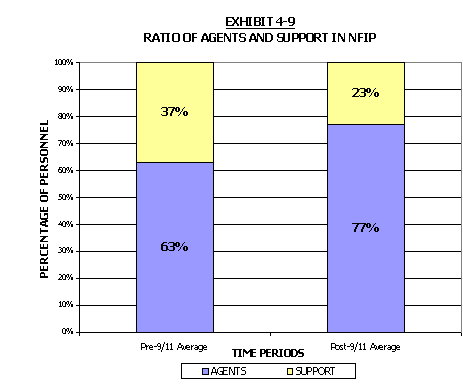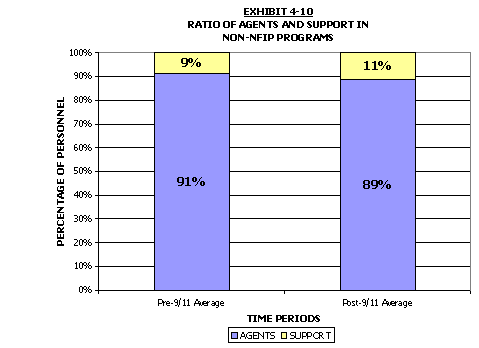Subsequent to this shift in agent work effort, in December 2001 the FBI Director announced his plan for reorganizing the Bureau and his intent to formally transfer additional resources to terrorism-related work. As noted in the schedule of agent allocations for FY 2002 found in Exhibit 1-2, the Director increased the special agent allocation in terrorism-related programs from 2,212 to 2,897 in May 2002.
Overall Increase – The dramatic increase in work hours dedicated to NFIP in the weeks following 9/11 did not come solely at the expense of other programs. Much of the immediate increase in both agent and support work hours was due to the large amounts of overtime worked in the initial weeks following the 9/11 attacks. This can be seen by looking at the total number of work hours expended by FBI special agents and support personnel both before and after 9/11.
As shown in the following graph, the terrorist attacks, which occurred during TURK period 13 of FY ;2001, resulted in a large increase in total agent work hours in all programs combined. On average, FBI agents were working 1.89 million hours per TURK period in the year prior to 9/11. In TURK period 3, this work effort increased to almost 2.12 million hours, an increase of about 12 percent.
Similar to agents, FBI support personnel worked significantly more hours than normal in response to 9/11. As shown in the following graph, support work hours progressed from an average of about 315,000 in the year just prior to 9/11, to about 340,000 immediately after (in TURK period 1 of FY 2002), reflecting an 8 percent increase.
Changes Within FBI Programs – The changes in FBI resource utilization can be seen within its investigative program areas. The following graphs (Exhibits 4-4 and 4-5) of special agent and support personnel work hours in these program areas highlight three distinct time periods: the time prior to 9/11, the immediate response to 9/11, and the stabilization of work hours after 9/11.
Between September 2000 and August 2001, the FBI consistently utilized most of its agent resources in its White Collar Crime, Organized Crime/Drugs, and Violent Crimes and Major Offenders programs. This changed dramatically after 9/11, when agent hours in NFIP increased by almost 400 percent, from just over 300,000 hours to almost 1.5 million hours. At the same time, agent hours in all other programs decreased. After NFIP agent work hours reached their post-9/11 peak, the level of effort gradually declined and stabilized, leveling out between February and March of 2002. However, although the NFIP agent work hours decreased as time went on, the stabilized level of effort was at a rate higher than prior to 9/11. NFIP agent work hours increased by about 62 percent per TURK period, from just over 300,000 in TURK period 12 of FY 2001 to over 485,000 in TURK period 9 of FY 2002.
For the same timeframe, work hours expended by support personnel in the National Foreign Intelligence Program rose from about 157,000 to more than 175,000, an increase of about 12 percent. This increase is displayed in Exhibit 4-5.
In summary, in the weeks immediately following the 9/11 attacks, FBI personnel in general worked significantly more hours than usual. This increase in work effort was directed to NFIP, while all other programs experienced decreases in work hours. In the months after 9/11, NFIP stabilized and replaced White Collar Crime as the program expending the largest amount of agent work hours.
Changes in Personnel Distribution
In addition to reviewing the hours worked in each program before and after 9/11, we compared the level of effort in the program, in terms of personnel on board, as percentages of total FBI investigative activity. In this analysis we averaged, for each investigative program, the annual fiscal year personnel totals for FYs 1996 through 2001 and compared these to the personnel totals for FY 2002.36
The following chart highlights the changes in the percentages of total personnel (agents and support combined) working in each investigative program. The blue bars show pre-9/11 data, while the maroon bars provide post-9/11 data.37
|
EXHIBIT 4-6 PERCENTAGE OF OVERALL WORK FORCE IN FBI PROGRAMS BEFORE AND AFTER 9/11 |
|---|
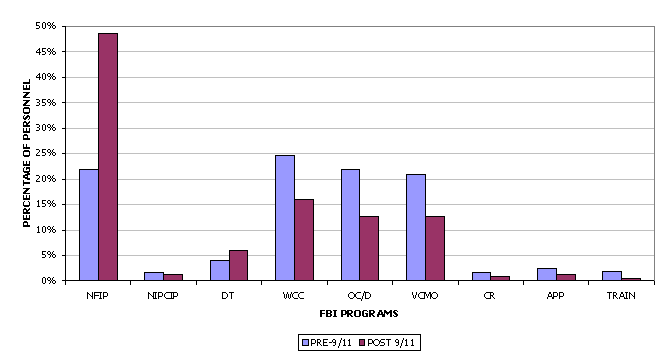
|
| Source: FBI TURK System |
Exhibit 4-6 demonstrates that the percentage of combined agent and support personnel working in the FBI’s National Foreign Intelligence Program more than doubled, from approximately 22 percent prior to FY 2002 to over 48 percent in the eight months of FY 2002 in our review. In addition, the percentage in the Domestic Terrorism program also rose, from four percent to six percent. At the same time, the percentage of FBI personnel working on both White Collar Crime and Organized Crime/Drugs matters dropped nine percent, and the percentage working on Violent Crimes and Major Offenders activities dropped eight percent.
We also separately analyzed personnel percentages for special agents and support personnel. Exhibit 4-7 compares the percentages of agents working in FBI programs for the two time periods (i.e., October 1, 1995, through September 22, 2001, and September 23, 2001, through June 1, 2002).
|
EXHIBIT 4-7 PERCENTAGE OF AGENTS IN FBI PROGRAMS BEFORE AND AFTER 9/11 |
|---|
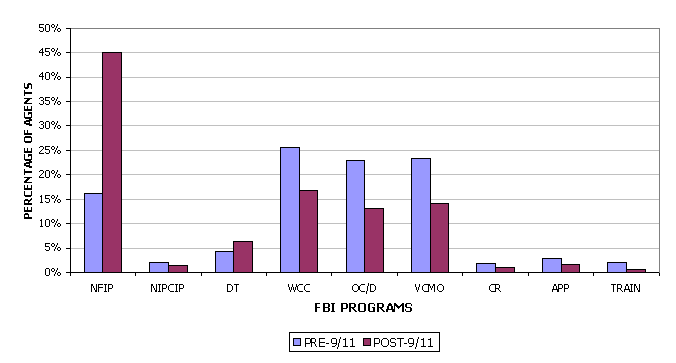 |
| Source: FBI TURK System |
As in the analysis of the overall workforce displayed in Exhibit 4-6, the percentage of agents increased in the National Foreign Intelligence and Domestic Terrorism programs, while percentages for all other programs decreased. In the case of agents, though, instead of doubling, the percentage in NFIP almost tripled, from 16 percent to 45 percent.
The following chart shows the same breakdown of data for support personnel. Similar to the changes experienced in the agent work force, the percentage of support personnel working in NFIP also increased, although not by as large a margin. Prior to FY 2002, NFIP already accounted for more than half (56 percent) of all support personnel; by June 2002, it had increased by an additional 10 percent. Analogous with the trend for agents, the percentage of support personnel in DT also increased and the percentage in all other programs decreased.
|
EXHIBIT 4-8 PERCENTAGE OF SUPPORT PERSONNEL IN FBI PROGRAMS BEFORE AND AFTER 9/11 |
|---|
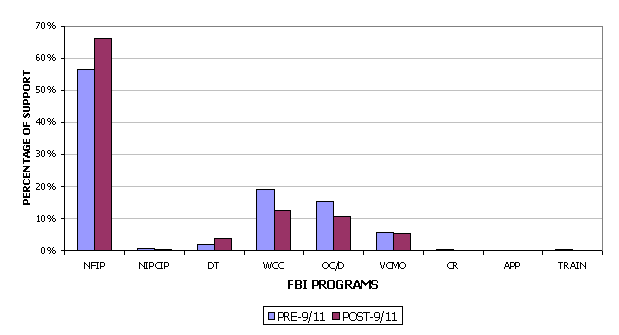 |
| Source: FBI TURK System |
The higher percentages of both agents and support personnel working in the FBI’s terrorism-related programs after 9/11 are in accord with the FBI Director’s mandate to make counterterrorism the FBI’s top priority. NFIP had the largest percentage of support personnel prior to 9/11, and its share grew even larger afterwards. In the case of agents, the increase in NFIP personnel moved it past other programs to become the largest FBI program in terms of agent utilization.
Ratio of Agents to Support Before and After 9/11
In our previous analyses, we noted significant changes in the percentages of agents working in different FBI investigative programs before and after 9/11. Since the changes in support personnel percentages were not as significant, the ratio of support personnel to special agents within FBI programs also was altered.
Prior to 9/11, the FBI consistently utilized most of its agent resources in its White Collar Crime, Organized Crime/Drugs, and Violent Crimes and Major Offenders programs. This changed dramatically in the immediate aftermath of the terrorist attacks of 9/11, when the average number of NFIP agent hours worked in the year prior to 9/11 increased by almost 400 percent in the TURK period immediately following 9/11. The National Foreign Intelligence Program, which had accounted for only 22 percent of combined agent and support work effort prior to 9/11, grew to over 48 percent of the combined work effort for the 8 months of our review period in FY 2002. Much of the immediate increase in both agent and support work effort was due to the large amounts of overtime worked in the initial weeks following the 9/11 attacks. However, as the work effort stabilized, leveling off between February and March 2002, NFIP replaced White Collar Crime as the program expending the largest amount of agent work hours.
Footnotes
- Personnel totals are computed using Average On Board figures, as defined in Chapter 2.
- We have defined the pre-9/11 period in our review as October 1, 1995, through September 22, 2001, which was the last day of TURK period 13 of FY 2001. For the purposes of our review, the post-9/11 period began on September 23, 2001.
